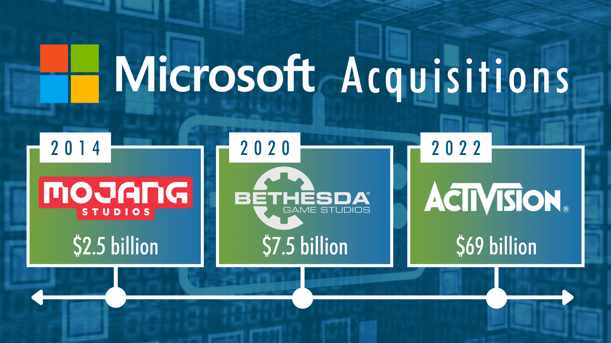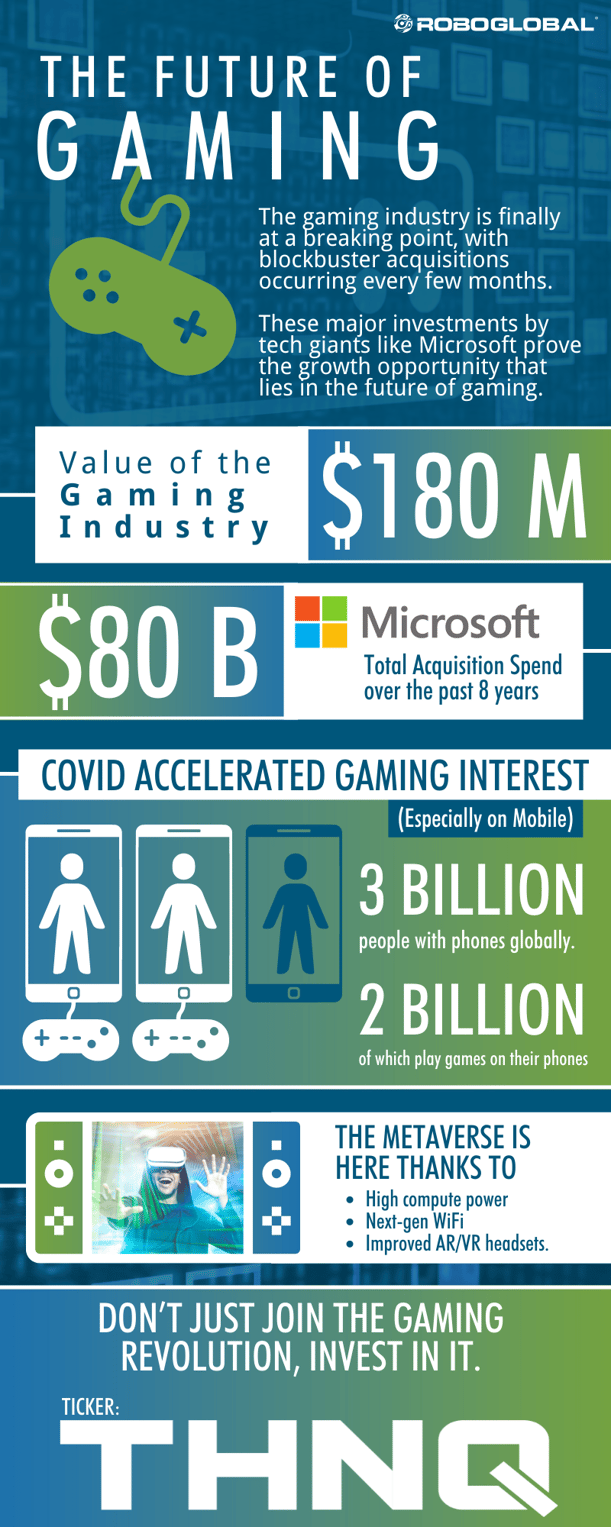Who could have predicted that the largest technology acquisition would be a company that developed a video game that rewards you for crushing a row of candy? The $180 billion gaming industry is finally at a breaking point, with blockbuster acquisitions occurring every few months. Most recently was Microsoft’s declared intent on January 18, 2022, to acquire Activision for nearly $70 billion in cash. Aside from being its largest gaming acquisition to date, it’s also Microsoft’s largest technology acquisition.
To understand how we got here, it is important to go back to Microsoft’s $2.5 billion acquisition of Mojang, the creator of Minecraft, in 2014. The Minecraft franchise is one of the most successful games of all time, played by over 140 million gamers on PCs, consoles, and mobile devices around the world. Minecraft is one of the first metaverse games ever created and is still popular today.
In 2020, Microsoft also purchased a small developer called Bethesda for $7.5 billion. These major investments by tech giants like Microsoft prove the power that lies in the future of gaming.

Major Shifts in the Gaming Industry Driving Change
The Metaverse Has Emerged
The future of the gaming world will continue to live on the mobile phone, but the emergence of the metaverse is changing gaming as we know it. Multi-player, virtual reality (VR), avatars, and connected devices all loosely prove how quickly the metaverse is taking over the gaming world.
While the speed of adoption relies on a few things like whether the Activision deal gets approved and if Sony maintains its global dominance, one thing is certain in the gaming world: the Metaverse is here to stay. The metaverse is an immersive world where people can “live” a second life through an avatar, also known as their “digital existence.” In this digital world, users interact with each other using advanced human-computer interaction technology where they can do everything from building a home and collecting treasures to sharing experiences in a community with other players—and none of these things physically exist. Thanks to high compute power, next-gen WiFi, and improved AR/VR headsets like the upcoming Oculus 3, the metaverse experience is now possible for gamers and will evolve in the years to come.

M&A Strategy in Gaming Has Changed
In the past, we saw traditional gaming companies investing in assets that had a proven hit or established franchises. This is changing. Now emerging players with strong developer teams are being acquired. From a gamer standpoint, this is far from ideal, as innovation can significantly slow down under the control of large tech giants. But it’s clear that releasing a hit game that is consistent with the type of digital experience that consumers are demanding will grow increasingly more difficult. Independent producers will have a hard time surviving with tech giants flexing their muscles.
Cloud Subscription Fees Will Rise
The rise of game streaming is complicated, and not all game providers can navigate through it alone. Issues on how content is distributed and played—and on what platform—will further consolidate the industry. Microsoft and Sony are competing in the cloud gaming space by gobbling up franchises and independent game producers as quickly as they can. Expect your cloud subscription fees (including movie streaming services) to increase over time. And Xbox cloud users will get a slew of new titles including languishing or discontinued games such as War of Warcraft, Tony Hawk, and Diablo series.
Covid Has Accelerated Demand for Gaming (Especially on Mobile)
Despite this pandemic-inspired demand, we believe that the gaming boom has legs longer term. Mobile gaming is the crown jewel in the gaming industry, and new business models have emerged. The mobile gaming industry grew over 7% last year and brought in over $80 billion of revenues according to Newzoo.
![]() Over 3 billion people have mobile phones globally, and over 2 billion of those play games on their phones.
Over 3 billion people have mobile phones globally, and over 2 billion of those play games on their phones.
According to NPD data, players are spending more money on mobile games than console and PC games combined, as accessories, outfits, and weapons are emerging in the pay-to-play model. This explains why Take Two acquired Zynga for $12 billion just a week before Microsoft’s announcement. Take Two, which is known for Grand Theft Auto, is hoping to tap into the continued growth of mobile, which accounts for more than half of the entire video game industry.
All in all, there’s no doubt that the future of gaming will be one of massive popularity, emerging in a digital world unlike any we’ve seen before. The companies leading the gaming revolution are deeply involved in the development and application of AI technologies. Investors can gain diverse exposure to the companies paving the path for immersive digital gaming through the ROBO Global Artificial Intelligence Index (ticker: THNQ). Don’t just join the gaming revolution, invest in it.





